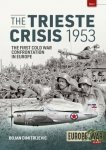-
Załączniki bezpieczeństwa
Załczniki do produktuZałączniki dotyczące bezpieczeństwa produktu zawierają informacje o opakowaniu produktu i mogą dostarczać kluczowych informacji dotyczących bezpieczeństwa konkretnego produktu
-
Informacje o producencie
Informacje o producencieInformacje dotyczące produktu obejmują adres i powiązane dane producenta produktu.HELION
-
Osoba odpowiedzialna w UE
Osoba odpowiedzialna w UEPodmiot gospodarczy z siedzibą w UE zapewniający zgodność produktu z wymaganymi przepisami.
Series : Latin America@War #14
Author : Mariano Sciaroni
Paperback Helion & Company 297mm x 210mm 88 pages 74 b/w photos, 8 colour photos, 12 colour profiles, 8 maps, 3 tables, 3 diagrams
The naval warfare of the last few decades appears dominated by operations of fast missile craft and a wide diversity of other minor vessels in so-called ‘littoral warfare’. On the contrary, skills and knowledge about anti-submarine warfare on the high seas – a discipline that dominated much of the World War II, and once used to be the reason for existence of large fleets of the North Atlantic Treaty Organisation (NATO) and of the Warsaw Pact – appear nearly extinct. Indeed, it seems that no armed conflicts involving this form of naval warfare have been fought for a significant time. As so often, the reality is entirely different. Submarine and anti-submarine warfare remain one of most sophisticated forms of armed conflicts to this day. Unsurprisingly, considering the amount of high-technology equipment necessary for their conduct, they are shrouded behind a thick veil of secrecy. This is why the operations of the sole Argentinean aircraft carrier – ARA 25 de Mayo – during the much-publicised war in the South Atlantic of 1982 remain largely unknown until this very day. It is well-known that the United Kingdom deployed the largest task force its Royal Navy had assembled since the Korean War over 12,000 kilometres away from home. It is well-known that the operations of this task force proved decisive for the outcome of the war: it not only brought the air power that established itself in control of the air space over the battlefield, but also hauled all the troops and supplies necessary to recover the islands that were the core of the dispute. However, the impression created very early during this conflict – and largely maintained until today – is that ARA 25 de Mayo and other elements of the accompanying Task Force 79 of the Argentinean Navy were forced into a hurried withdrawal by the sheer presence of multiple nuclear attack submarines of the Royal Navy. Based on years of research, including extensive investigation into naval operations of both sides of the conflict, ‘A Carrier at Risk’ is a vibrant and lucid account of a week-long cat-and-mouse game between anti-submarine warfare specialists on board ARA 25 de Mayo, and multiple nuclear attack submarines of the Royal Navy: an entirely unknown, yet crucial aspect of the South Atlantic War. Illustrated by over 100 photographs, maps, and colour profiles, this volume closes one of the major gaps – though also a crucially important affair – in the coverage of this conflict.
‘It offers a valuable contribution both to their professional educations and to the wider field of naval history more generally.’ Baird Maritime
"The text has been translated from Spanish and it reads well. Better, the authro has largely avoided taking a partisan approach to his subject. The photo selection is to be commended for its originality." Aeroplane Monthly
"Mariano Sciaroni is highly qualified to write this story, which he tells well, revealing the depth of his research. The book is extremely well illustrated with a whole host of illustrations, drawings, diagrams and a splendid series of excellent, full page maps as well as ship and aircraft line artwork. There are many photographs. It is beautifully produced though sadly printed in A4 magazine format. Very readable and well recommended." Scuttlebutt
Additional Information
Publisher
Helion & Company
ISBN
9781911628705
Date of Publication
March 2019
Binding
Paperback
Book Size
297mm x 210mm
Pages
88 pages
Images
74 b/w photos, 8 colour photos, 12 colour profiles, 8 maps, 3 tables, 3 diagrams
Language
English Text









